park assist Hyundai Santa Fe 2009 Owner's Manual - RHD (UK, Australia)
[x] Cancel search | Manufacturer: HYUNDAI, Model Year: 2009, Model line: Santa Fe, Model: Hyundai Santa Fe 2009Pages: 269, PDF Size: 9.78 MB
Page 59 of 269
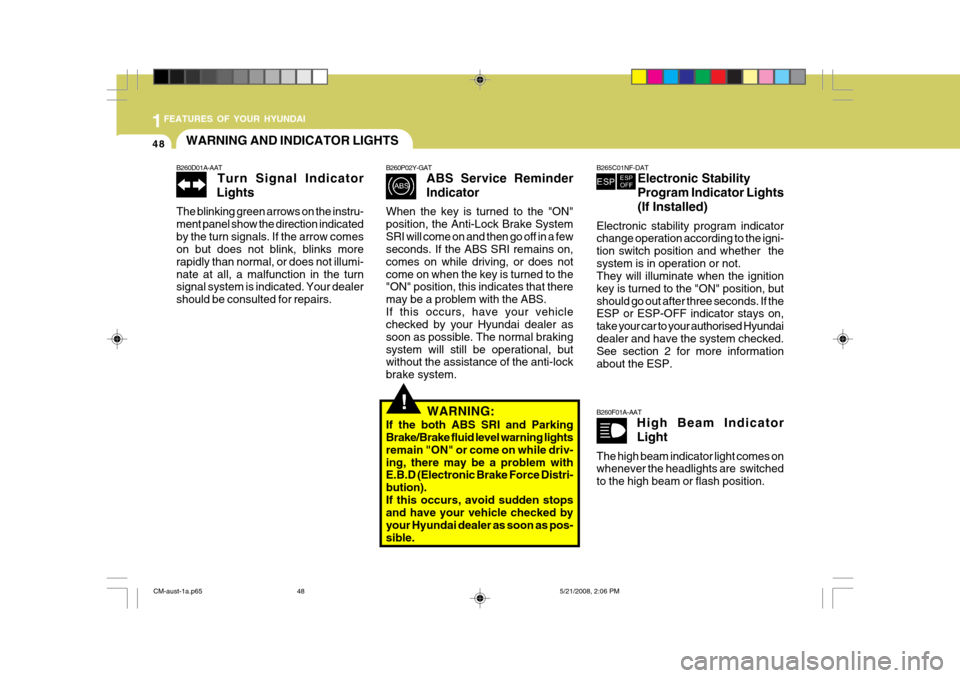
1FEATURES OF YOUR HYUNDAI
48
B260D01A-AAT
Turn Signal Indicator
Lights
The blinking green arrows on the instru- ment panel show the direction indicatedby the turn signals. If the arrow comes on but does not blink, blinks more rapidly than normal, or does not illumi-nate at all, a malfunction in the turn signal system is indicated. Your dealer should be consulted for repairs. WARNING AND INDICATOR LIGHTS
B260F01A-AAT
High Beam Indicator Light
The high beam indicator light comes on whenever the headlights are switched to the high beam or flash position.!
B260P02Y-GAT ABS Service Reminder Indicator
When the key is turned to the "ON" position, the Anti-Lock Brake SystemSRI will come on and then go off in a few seconds. If the ABS SRI remains on, comes on while driving, or does notcome on when the key is turned to the "ON" position, this indicates that there may be a problem with the ABS.If this occurs, have your vehicle checked by your Hyundai dealer as soon as possible. The normal brakingsystem will still be operational, but without the assistance of the anti-lock brake system.
WARNING:
If the both ABS SRI and Parking Brake/Brake fluid level warning lights remain "ON" or come on while driv-ing, there may be a problem with E.B.D (Electronic Brake Force Distri- bution).If this occurs, avoid sudden stops and have your vehicle checked by your Hyundai dealer as soon as pos-sible.
B265C01NF-DAT Electronic Stability Program Indicator Lights(If Installed)
Electronic stability program indicator change operation according to the igni- tion switch position and whether thesystem is in operation or not. They will illuminate when the ignition key is turned to the "ON" position, butshould go out after three seconds. If the ESP or ESP-OFF indicator stays on, take your car to your authorised Hyundaidealer and have the system checked. See section 2 for more information about the ESP.
CM-aust-1a.p65 5/21/2008, 2:06 PM
48
Page 165 of 269
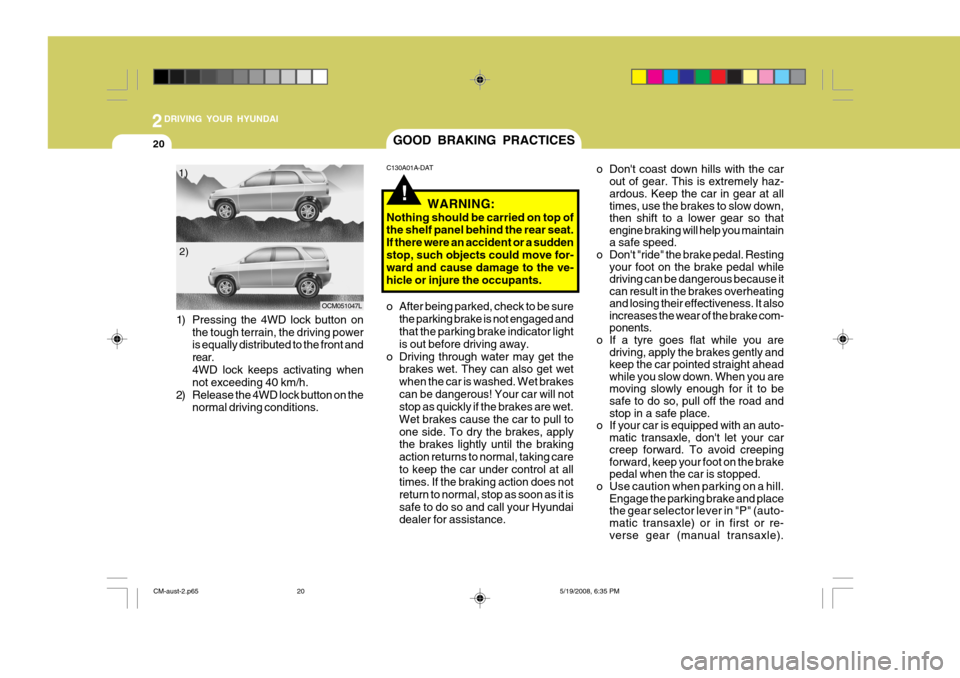
2DRIVING YOUR HYUNDAI
20
!
GOOD BRAKING PRACTICES
C130A01A-DAT o Don't coast down hills with the car
out of gear. This is extremely haz- ardous. Keep the car in gear at all times, use the brakes to slow down,then shift to a lower gear so thatengine braking will help you maintaina safe speed.
o Don't "ride" the brake pedal. Resting
your foot on the brake pedal whiledriving can be dangerous because itcan result in the brakes overheatingand losing their effectiveness. It alsoincreases the wear of the brake com-ponents.
o If a tyre goes flat while you are driving, apply the brakes gently andkeep the car pointed straight aheadwhile you slow down. When you aremoving slowly enough for it to besafe to do so, pull off the road and stop in a safe place.
o If your car is equipped with an auto-
matic transaxle, don't let your car creep forward. To avoid creepingforward, keep your foot on the brakepedal when the car is stopped.
o Use caution when parking on a hill. Engage the parking brake and placethe gear selector lever in "P" (auto-matic transaxle) or in first or re-
verse gear (manual transaxle).
WARNING:
Nothing should be carried on top ofthe shelf panel behind the rear seat. If there were an accident or a suddenstop, such objects could move for- ward and cause damage to the ve- hicle or injure the occupants.
o After being parked, check to be sure the parking brake is not engaged and that the parking brake indicator light is out before driving away.
o Driving through water may get the brakes wet. They can also get wet when the car is washed. Wet brakescan be dangerous! Your car will not stop as quickly if the brakes are wet. Wet brakes cause the car to pull toone side. To dry the brakes, apply the brakes lightly until the braking action returns to normal, taking careto keep the car under control at all times. If the braking action does not return to normal, stop as soon as it issafe to do so and call your Hyundai dealer for assistance.
1) Pressing the 4WD lock button on
the tough terrain, the driving power is equally distributed to the front and rear. 4WD lock keeps activating when not exceeding 40 km/h.
2) Release the 4WD lock button on the normal driving conditions.
1)
2)
OCM051047L
CM-aust-2.p65 5/19/2008, 6:35 PM
20
Page 177 of 269
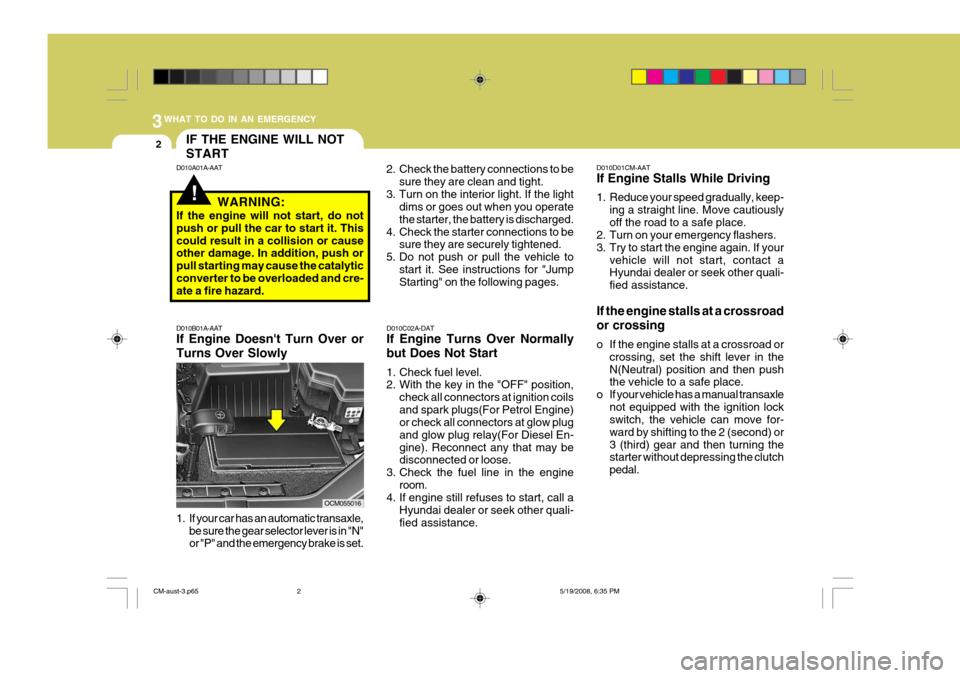
3WHAT TO DO IN AN EMERGENCY
2
!
IF THE ENGINE WILL NOT START
1. If your car has an automatic transaxle, be sure the gear selector lever is in "N" or "P" and the emergency brake is set.
D010B01A-AAT If Engine Doesn't Turn Over or Turns Over Slowly
D010A01A-AAT
D010D01CM-AAT If Engine Stalls While Driving
1. Reduce your speed gradually, keep-
ing a straight line. Move cautiously off the road to a safe place.
2. Turn on your emergency flashers.
3. Try to start the engine again. If your
vehicle will not start, contact a Hyundai dealer or seek other quali- fied assistance.
If the engine stalls at a crossroad or crossing
o If the engine stalls at a crossroad or crossing, set the shift lever in the N(Neutral) position and then push the vehicle to a safe place.
o If your vehicle has a manual transaxle not equipped with the ignition lockswitch, the vehicle can move for- ward by shifting to the 2 (second) or3 (third) gear and then turning the starter without depressing the clutch pedal.
D010C02A-DAT If Engine Turns Over Normally but Does Not Start
1. Check fuel level.
2. With the key in the "OFF" position,
check all connectors at ignition coils and spark plugs(For Petrol Engine) or check all connectors at glow plug and glow plug relay(For Diesel En-gine). Reconnect any that may be disconnected or loose.
3. Check the fuel line in the engine
room.
4. If engine still refuses to start, call a
Hyundai dealer or seek other quali- fied assistance.
WARNING:
If the engine will not start, do notpush or pull the car to start it. Thiscould result in a collision or cause other damage. In addition, push or pull starting may cause the catalyticconverter to be overloaded and cre- ate a fire hazard.
OCM0550162. Check the battery connections to be
sure they are clean and tight.
3. Turn on the interior light. If the light dims or goes out when you operate the starter, the battery is discharged.
4. Check the starter connections to be sure they are securely tightened.
5. Do not push or pull the vehicle to start it. See instructions for "Jump Starting" on the following pages.
CM-aust-3.p65 5/19/2008, 6:35 PM
2
Page 178 of 269
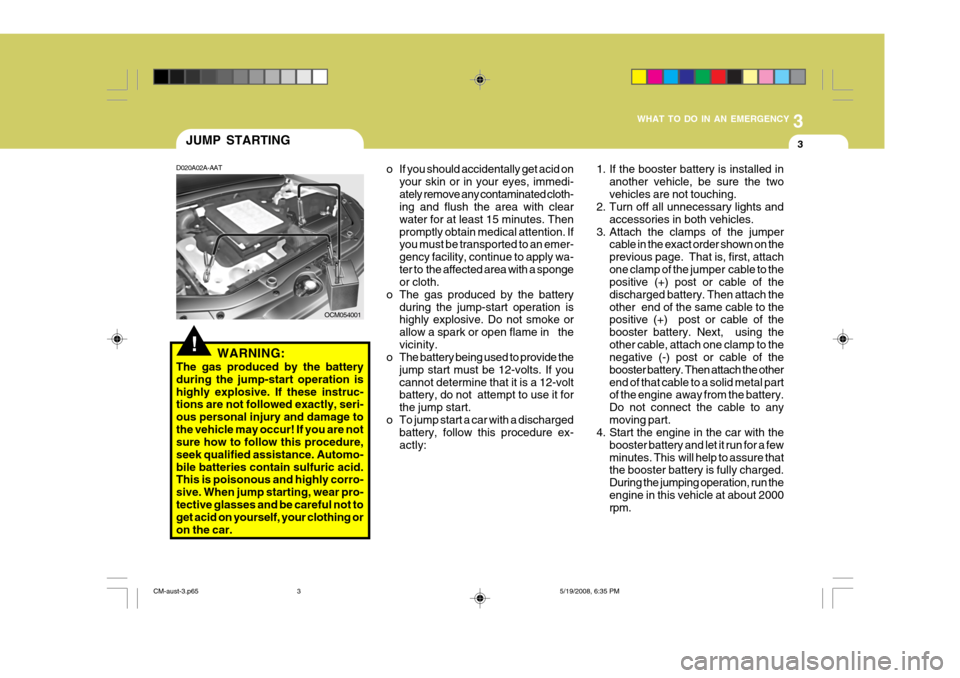
3
WHAT TO DO IN AN EMERGENCY
3
!
OCM054001
JUMP STARTING
D020A02A-AAT
WARNING:
The gas produced by the battery during the jump-start operation ishighly explosive. If these instruc- tions are not followed exactly, seri- ous personal injury and damage tothe vehicle may occur! If you are not sure how to follow this procedure, seek qualified assistance. Automo-bile batteries contain sulfuric acid. This is poisonous and highly corro- sive. When jump starting, wear pro-tective glasses and be careful not to get acid on yourself, your clothing or on the car. o If you should accidentally get acid on
your skin or in your eyes, immedi-ately remove any contaminated cloth- ing and flush the area with clear water for at least 15 minutes. Thenpromptly obtain medical attention. If you must be transported to an emer- gency facility, continue to apply wa-ter to the affected area with a sponge or cloth.
o The gas produced by the battery
during the jump-start operation ishighly explosive. Do not smoke or allow a spark or open flame in thevicinity.
o The battery being used to provide the
jump start must be 12-volts. If youcannot determine that it is a 12-volt battery, do not attempt to use it for the jump start.
o To jump start a car with a discharged battery, follow this procedure ex-actly: 1. If the booster battery is installed in
another vehicle, be sure the twovehicles are not touching.
2. Turn off all unnecessary lights and
accessories in both vehicles.
3. Attach the clamps of the jumper cable in the exact order shown on theprevious page. That is, first, attachone clamp of the jumper cable to the positive (+) post or cable of the discharged battery. Then attach theother end of the same cable to the positive (+) post or cable of the booster battery. Next, using theother cable, attach one clamp to the negative (-) post or cable of the booster battery. Then attach the otherend of that cable to a solid metal part of the engine away from the battery. Do not connect the cable to anymoving part.
4. Start the engine in the car with the
booster battery and let it run for a fewminutes. This will help to assure that the booster battery is fully charged. During the jumping operation, run theengine in this vehicle at about 2000 rpm.
CM-aust-3.p65 5/19/2008, 6:35 PM
3
Page 212 of 269
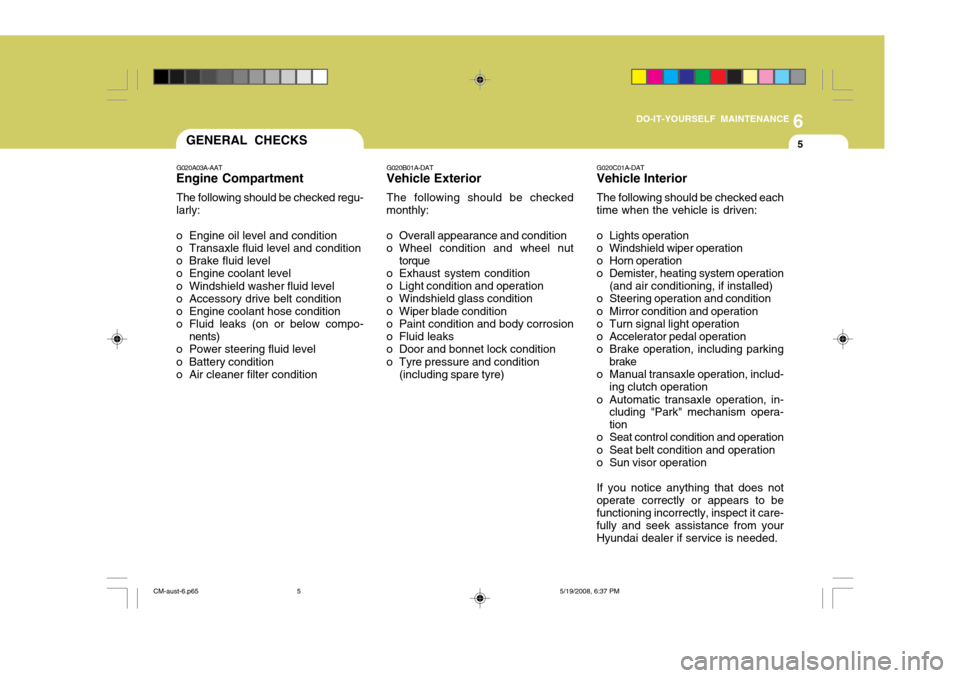
6
DO-IT-YOURSELF MAINTENANCE
5GENERAL CHECKS
G020A03A-AAT
Engine Compartment
The following should be checked regu- larly:
o Engine oil level and condition
o Transaxle fluid level and condition
o Brake fluid level
o Engine coolant level
o Windshield washer fluid level
o Accessory drive belt condition
o Engine coolant hose condition
o Fluid leaks (on or below compo- nents)
o Power steering fluid level
o Battery condition
o Air cleaner filter condition G020B01A-DAT
Vehicle Exterior
The following should be checked
monthly:
o Overall appearance and condition
o Wheel condition and wheel nut
torque
o Exhaust system condition
o Light condition and operation
o Windshield glass condition
o Wiper blade condition
o Paint condition and body corrosion
o Fluid leaks
o Door and bonnet lock condition
o Tyre pressure and condition (including spare tyre) G020C01A-DAT Vehicle Interior The following should be checked each time when the vehicle is driven:
o Lights operation
o Windshield wiper operation
o Horn operation
o Demister, heating system operation
(and air conditioning, if installed)
o Steering operation and condition
o Mirror condition and operation
o Turn signal light operation
o Accelerator pedal operation
o Brake operation, including parking
brake
o Manual transaxle operation, includ-
ing clutch operation
o Automatic transaxle operation, in- cluding "Park" mechanism opera-tion
o Seat control condition and operation
o Seat belt condition and operation
o Sun visor operation If you notice anything that does not operate correctly or appears to befunctioning incorrectly, inspect it care- fully and seek assistance from your Hyundai dealer if service is needed.
CM-aust-6.p65 5/19/2008, 6:37 PM
5
Page 231 of 269
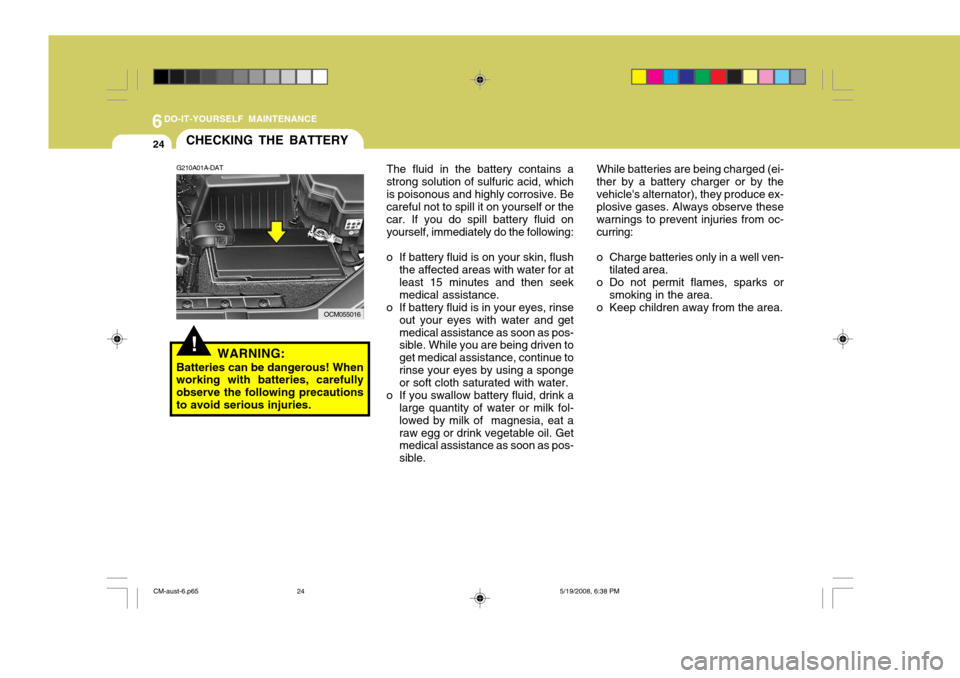
6DO-IT-YOURSELF MAINTENANCE
24
!
CHECKING THE BATTERY
The fluid in the battery contains a strong solution of sulfuric acid, whichis poisonous and highly corrosive. Be careful not to spill it on yourself or the car. If you do spill battery fluid onyourself, immediately do the following:
o If battery fluid is on your skin, flush the affected areas with water for atleast 15 minutes and then seekmedical assistance.
o If battery fluid is in your eyes, rinse
out your eyes with water and getmedical assistance as soon as pos- sible. While you are being driven to get medical assistance, continue torinse your eyes by using a sponge or soft cloth saturated with water.
o If you swallow battery fluid, drink a large quantity of water or milk fol- lowed by milk of magnesia, eat araw egg or drink vegetable oil. Get medical assistance as soon as pos- sible.
G210A01A-DAT
WARNING:
Batteries can be dangerous! When working with batteries, carefully observe the following precautionsto avoid serious injuries. While batteries are being charged (ei-
ther by a battery charger or by thevehicle's alternator), they produce ex- plosive gases. Always observe these warnings to prevent injuries from oc-curring:
o Charge batteries only in a well ven- tilated area.
o Do not permit flames, sparks or smoking in the area.
o Keep children away from the area.
OCM055016
CM-aust-6.p65 5/19/2008, 6:38 PM
24
Page 252 of 269
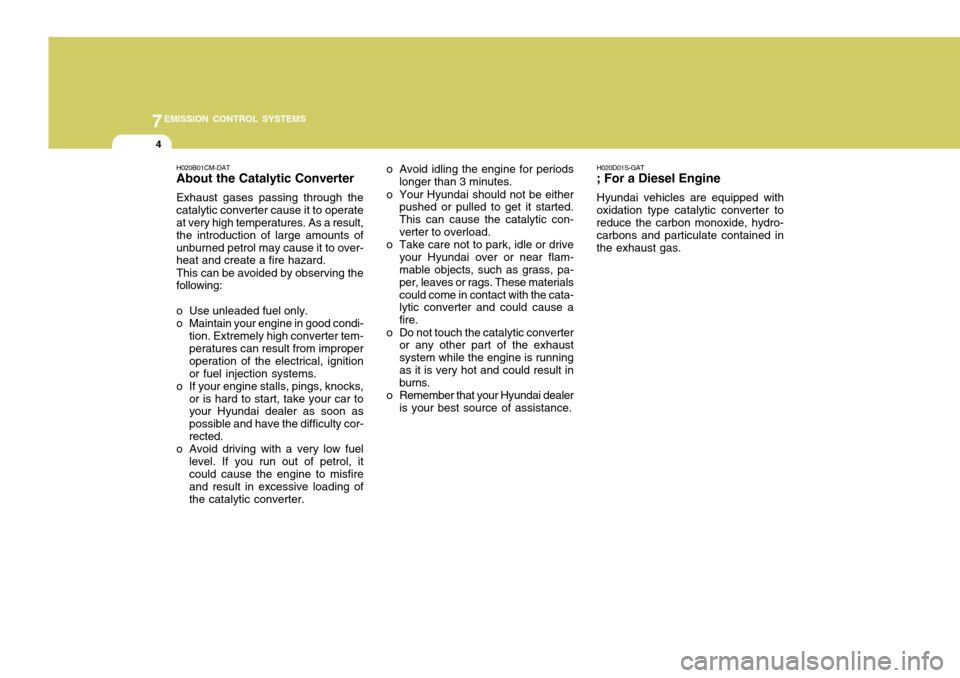
7EMISSION CONTROL SYSTEMS
4
o Avoid idling the engine for periodslonger than 3 minutes.
o Your Hyundai should not be either pushed or pulled to get it started. This can cause the catalytic con-verter to overload.
o Take care not to park, idle or drive your Hyundai over or near flam- mable objects, such as grass, pa- per, leaves or rags. These materialscould come in contact with the cata- lytic converter and could cause a fire.
o Do not touch the catalytic converter or any other part of the exhaustsystem while the engine is runningas it is very hot and could result in burns.
o Remember that your Hyundai dealer is your best source of assistance.
H020B01CM-DAT About the Catalytic Converter Exhaust gases passing through the catalytic converter cause it to operate at very high temperatures. As a result, the introduction of large amounts ofunburned petrol may cause it to over- heat and create a fire hazard. This can be avoided by observing the following:
o Use unleaded fuel only.
o Maintain your engine in good condi-
tion. Extremely high converter tem- peratures can result from improper operation of the electrical, ignitionor fuel injection systems.
o If your engine stalls, pings, knocks, or is hard to start, take your car to your Hyundai dealer as soon as possible and have the difficulty cor-rected.
o Avoid driving with a very low fuel
level. If you run out of petrol, itcould cause the engine to misfire and result in excessive loading of the catalytic converter. H020D01S-GAT
; For a Diesel Engine
Hyundai vehicles are equipped with
oxidation type catalytic converter to reduce the carbon monoxide, hydro- carbons and particulate contained inthe exhaust gas.